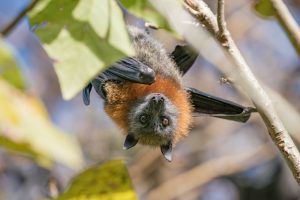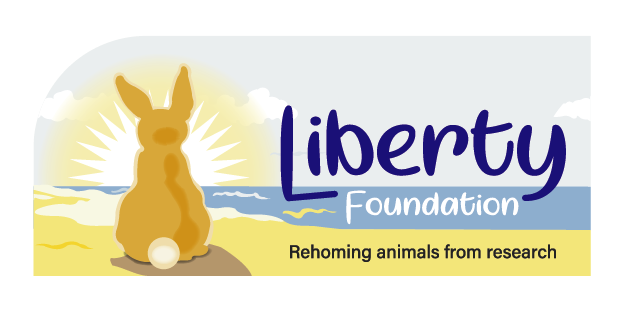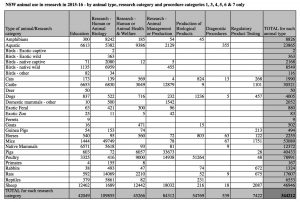The short answer is, that we don’t really know. This question cannot be answered accurately with the information that is currently publically available. However, we do know that there are hundreds of organisations licensed to use animals for research and scientific purposes in Australia, and there are dogs and cats (as well as many other species) that could be rehomed that are currently euthanised at the conclusion of research.
The long answer is that we can use the available data to derive a rough idea of:
- the number of animals in four Australian states that could be available, but not necessarily suitable, for rehoming.
- the number of dogs and cats in NSW only, that could be available, but not necessarily suitable, for rehoming.
The approximate nature of these figures derives from the fact that:
– not all Australian states and territories publicly release data on animal useage for scientific purposes. The data used in this post comes from NSW, Victoria, Tasmania and WA. This is relevant given that the majority of research involving animals occurs in NSW and Victoria.
– Australian research institutions do not provide information on the numbers and types of animals that are suitable for rehoming specifically.
– Australian research institutions provide aggregated figures to state governments on their use of animals by species and the category of procedure. The only state which provides data that cross references species with the type of procedure involved is New South Wales, which enables analysis of approximate numbers and types of animals that may be suitable for rehoming in that state. For example, we can ascertain the number of mice that were subject to procedures that did not result in their death or involve genetic modification. Note, genetically modified animals are not suitable for rehoming as they must be kept in secure, specialist facilities by law.
1. Number of animals in Australia (NSW, VIC, TAS and WA only) that could be available, but not necessarily suitable, for rehoming
The latest available figures, for 2015, show that the percentage of animals used for non-observational[1] procedures in Australia, involving varying levels of invasiveness and challenge but not resulting in death was 20% (1.62 million animals) from a total of 8,130,937[2] used for scientific purposes. This is based on data from only four States of Australia but includes three of the largest user States of NSW, Victoria and Western Australia. In theory, it is animals from this group that could potentially be available, but not necessarily suitable, for rehabilitation and rehoming. This includes 608,503 animals from Victoria and 898,297 animals from NSW[3].
 It should be noted that the overall total in 2015 was skewed by an unusually large number of native animals reported in observational environmental studies in NSW, some 4,123,049. If these animals are removed from the overall national total (of data from four states) then the percentage of animals that could potentially be available for rehoming rises form 20% to more like 40%.
It should be noted that the overall total in 2015 was skewed by an unusually large number of native animals reported in observational environmental studies in NSW, some 4,123,049. If these animals are removed from the overall national total (of data from four states) then the percentage of animals that could potentially be available for rehoming rises form 20% to more like 40%.
Of the total for the four states recorded, across all types of research including observational studies, the largest group were rats and mice representing 38% (1.5 million animals); followed by fish, amphibians and other aquatic animals at 33% (1.3 million animals); as well as 675,572 poultry and other birds, 7,696 dogs, 2,939 cats, and 11,721 rabbits and guinea pigs.[4]
Around 8.6% (345,744 animals) of the animals recorded across the four states were involved in genetic modification, which are unable to rehomed.
It should also be noted that this information relates to only four states of Australia. It is estimated that other states/territories could account for a further 1,801,585 animals.[5]
2. Number of dogs and cats in NSW that could be available, but not necessarily suitable, for rehoming
What do we mean by ‘not necessarily suitable for rehoming’? Many companion animals such as dogs and cats are included in statistics of animals used for scientific purposes although they may only be consulting at university-based veterinary clinics and do not belong to the university. There may be other animals that while owned by the research facility, may not have a suitable temperament or physical or psychological condition to be rehomed.
What the latest figures (2015)[6] from NSW indicate is that there were large numbers of farm animals such as poultry, pigs, sheep and cattle being used for research purposes in NSW in a variety of procedures. Aside from the largest groups – rats, mice, amphibians and aquatic species – there were a number of animals that may be suitable for rehoming as shown in the table. These included captive native and exotic birds (2,170); cats (1,990); dogs (4,005); rabbits and guinea pigs (1,818); and horses (2,255).
It can be estimated therefore that up to 5,995 dogs and cats in 2015 could have been available for rehoming. However, a proportion of these would be animals being treated at university-based veterinary clinics as mentioned above that belong to members of the public.
Click on the image below to view the table: NSW animal use in research in 2015-16 by animal type, research category and selected procedure categories
Table notes:
Data includes procedure categories: 1, 3, 4, 5, 6, 7 only. It excludes procedure categories 2, 8 & 9 which involve death of the animal or production of genetically modified animals
Data excludes animals used for the purposes of stock breeding; stock maintenance; and environmental study
Descriptions of procedure categories:
- Observation with minor interference – included in table
- Animal unconscious without recovery – not included in table
- Minor conscious intervention – included in table
- Minor surgery with recovery – included in table
- Major surgery with recovery – included in table
- Minor physiological challenge – included in table
- Major physiological challenge – included in table
- Death as an endpoint – not included in table
- Production of genetically modified animals – not included in table
Where a cell is left empty it indicates zero animals were reported
Source: Animal Research Review Panel Annual Report 2015-2016, NSW Department of Primary Industries, 2017
Footnotes:
[1] Animals involved in observational studies are not included where they are considered non-invasive as
they are mostly conducted with free-living or sanctuary populations
[2] http://www.humaneresearch.org.au/statistics/statistics_2015
[3] http://www.humaneresearch.org.au/statistics/statistics_2015
[4] http://www.humaneresearch.org.au/statistics/statistics_2015
[5] http://www.humaneresearch.org.au/statistics/statistics_2015
[6] Animal Research Review Panel Annual Report 2015-2016, NSW Department of Primary Industries, 2017






